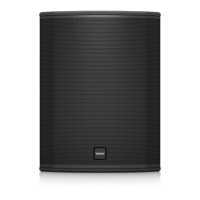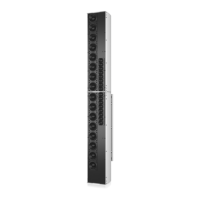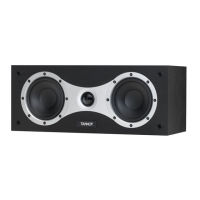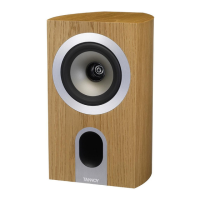Bi-wire Mode
Please note in bi-wire mode that the link cables should not be used. Best results will be obtained with a specially designed bi-wire
speaker cable.
If your ampli er is not equipped with two sets of output terminals, twist the Left LF+ (positive) and the Left HF+ (positive) together at the
ampli er end of the cables. Connect these to the ampli er Left channel positive terminal marked + (plus) or coloured red. Twist the Left
LF- (negative) and the HF- (negative) cables together and connect them to the ampli er Left channel negative terminal marked - (minus)
or coloured black.
At the loudspeaker end, connect the cables labelled Left LF+ and Left LF- to the left hand loudspeaker LF terminals, ensuring that you note the
polarity markings on the cable sheathing. Then proceed to connect the Left HF+ and Left HF- to the HF terminals on the same loudspeaker.
Repeat this process to connect the right hand loudspeaker to the ampli er right channel output, once again ensuring that polarity is
correct throughout.
Bi-amp Mode
LINKS REMOVED
POWER AMPLIFIER
L
+ -
R
+ -
TO RIGH
SPEAKER
TO ‘GROUND’ OR
‘EARTH’ CONNECTION
ON AMPLIFIER (OPTIONAL)
POWER AMPLIFIER
L
+-
R
+-
POWER AMPLIFIER
L
+-
R
+-
TO ‘GROUND’ OR
‘EARTH’ CONNECTION
ON AMPLIFIER (OPTIONAL)
LINKS REMOVED
T
O RIGHT
SPEAKER
Bi-amping extends the principle of bi-wiring one stage further. In this connection option, separate power ampli ers are used for bass and
treble signals in each loudspeaker. Four mono (or two stereo) ampli ers of the same type are required for a stereo pair of loudspeakers.
If two stereo ampli ers are used, it is recommended that one ampli er supply bass information to left and right loudspeakers and the other,
the treble information. It is important not to use the link cables on the terminal panel, otherwise ampli er damage may result.
Treble Adjustment
Each loudspeaker is tted with two controls located on the front ba e beneath the detachable grille. These high current switch blocks are
labelled ROLL OFF and ENERGY. They can be used to compensate for the varied acoustic characteristics of listening rooms. The controls should
be adjusted with the ampli er tone controls in the ‘ at’ or uncompensated position. Each loudspeaker should be adjusted individually.
Rotating the ampli er balance control, to select rst one loudspeaker and then the other, most easily achieves this.
The Energy control has ve positions. It allows the output of the high frequency compression drive unit to be increased or decreased from the
linear or ‘ at’ position over a frequency band from approximately 1 kHz to 27 kHz. The Roll O control has ve positions (+2, level, -2, -4 and
-6 dB per octave) and provides adjustment at extreme high frequencies from 5 kHz to 30 kHz.
The Energy control has a shelving e ect whereas the roll o control increases or decreases the slope of the extreme high frequency response.
The attest, most linear response from the loudspeaker will be obtained with both controls set at the LEVEL position, and this position should
be used for initial listening tests. If the overall quality of the high frequency sound seems too prominent the –1.5 or –3 positions for the Energy
control should be tried. If the sound appears subdued in the treble region +1.5 or +3 settings may be preferred. Once the energy control
setting has been established the Roll O control can be adjusted to reduce or slightly increase the extreme high frequency content if necessary.
Remember the changes that can be made by moving either control from one position to another are subtle. They may not easily be heard if
the programme material has very little content in the frequency band under consideration. Choose a well-balanced piece of music with a full
spectrum of sound. The correct setting will be found when the loudspeakers are no longer evident and only the musical performance is heard.
Cabinet Care
The cabinet is nished to exacting standards utilising carefully selected solid hardwood mouldings and matching real wood veneers. The wood
should only be cleaned with a dry cloth or with a light application of quality non-silicone furniture polish such as the specialist Tannoy wax
supplied in the accessory pack. Take care not to get polish on the grille cloth or lacquered front ba e.
In common with all solid wood furniture, exposure to extremes of heat, cold and varying humidity will cause the wood to ease slightly.
Therefore it is recommended that the loudspeaker is protected from environmental extremes to guard against any such occurrence. Any wood
will change colour when subjected to the UV content of ambient light and dry out over time, hence the need to ‘feed’ the wood with the wax
provided periodically.
Grille Removal
Special acoustically-transparent cloth is used in the grilles. However, for ultimate delity, the enthusiast will nd it is best to use these
loudspeakers with their grilles removed during listening. Grille removal is also necessary for access to the front panel controls.
The front grille is removed using the key provided. Turn the key in the key slot and pull the bottom of the grille away from the cabinet. The grille
will drop down from its upper location. Take care not to damage the wooden lower part of the cabinet. To replace the grille engage the top of
the grille into the slot in the cabinet and push the grill into the recess and lock in position.
14 15Quick Start GuidePRESTIGE GR CANTERBURY GR-OW

